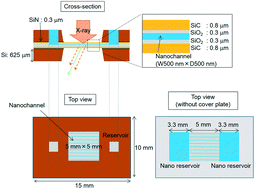Our official English website, www.x-mol.net, welcomes your
feedback! (Note: you will need to create a separate account there.)
Nano X-ray diffractometry device for nanofluidics
Lab on a Chip ( IF 6.1 ) Pub Date : 2018-03-29 00:00:00 , DOI: 10.1039/c8lc00077h Kazuma Mawatari 1, 2, 3, 4, 5 , Hiroki Koreeda 1, 2, 3, 4, 5 , Koji Ohara 5, 6, 7 , Shinji Kohara 5, 8, 9, 10 , Koji Yoshida 5, 11, 12, 13, 14 , Toshio Yamaguchi 5, 11, 12, 13, 14 , Takehiko Kitamori 1, 2, 3, 4, 5
Lab on a Chip ( IF 6.1 ) Pub Date : 2018-03-29 00:00:00 , DOI: 10.1039/c8lc00077h Kazuma Mawatari 1, 2, 3, 4, 5 , Hiroki Koreeda 1, 2, 3, 4, 5 , Koji Ohara 5, 6, 7 , Shinji Kohara 5, 8, 9, 10 , Koji Yoshida 5, 11, 12, 13, 14 , Toshio Yamaguchi 5, 11, 12, 13, 14 , Takehiko Kitamori 1, 2, 3, 4, 5
Affiliation

|
Nanofluidics is gaining attention because it has unique liquid and fluidic properties that are not observed in microfluidics. It has been reported that many liquid properties change when the size of a fluidic channel is reduced below 500–800 nm. To discuss the underlying mechanism, information on the microscopic liquid structure must be obtained (e.g., by X-ray diffractometry). However, the very small volume (attoliters to femtoliters) of a nanochannel and the large volume of its glass substrate prevent measurement of signals from the nanochannel liquid. In this study, we report a novel nanofluidic device that can be used in conjunction with X-ray diffractometry to analyze the structure of water confined in nanochannels. Top-down and bottom-up micro- and nano-fabrication processes were established, and the substrate thickness of the measurement area was reduced to only 2.7 μm, which was almost 1000 times smaller than that of conventional substrates (millimeter scale). With this new device, X-ray diffraction signals were clearly observed in nanochannels 500 nm wide and deep. Based on the X-ray diffraction pattern, the radial distribution function was calculated, which showed a structure nearly similar to that of a bulk sample. Therefore, X-ray diffractometry in nanochannels was realized. This method will provide important information on how a liquid behaves when confined in a nanospace and contribute to chemistry and biology on scales of 10–100 nm (e.g., inter- and intra-cellular spaces). It is also important for designing chemical reactions and fluidic circuits in nanochannels for realizing highly functional devices.
中文翻译:

用于纳米流体的纳米X射线衍射仪
纳米流体之所以受到关注,是因为它具有独特的液体和流体特性,而微流体中没有这种特性。据报道,当流体通道的尺寸减小到500-800 nm以下时,许多液体性质都会发生变化。为了讨论潜在的机理,必须获得有关微观液体结构的信息(例如,通过X射线衍射法)。但是,纳米通道的体积非常小(从升到飞升),其玻璃基板的体积很大,因此无法测量来自纳米通道液体的信号。在这项研究中,我们报告了一种新型的纳米流体装置,可以将其与X射线衍射仪结合使用,以分析受限于纳米通道中的水的结构。建立了自上而下和自下而上的微细加工和纳米加工工艺,测量区域的基板厚度减小到仅2.7μm,几乎是传统基板(毫米级)的1000倍。使用这种新设备,可以在宽和深500 nm的纳米通道中清晰地观察到X射线衍射信号。根据X射线衍射图,计算出径向分布函数,它的结构几乎与散装样品相似。因此,实现了纳米通道中的X射线衍射。该方法将提供有关液体在纳米空间中的行为的重要信息,并有助于10-100 nm范围内的化学和生物学(例如,细胞间和细胞内的空间)。对于设计纳米通道中的化学反应和流体回路以实现功能强大的设备,这也很重要。
更新日期:2018-03-29
中文翻译:

用于纳米流体的纳米X射线衍射仪
纳米流体之所以受到关注,是因为它具有独特的液体和流体特性,而微流体中没有这种特性。据报道,当流体通道的尺寸减小到500-800 nm以下时,许多液体性质都会发生变化。为了讨论潜在的机理,必须获得有关微观液体结构的信息(例如,通过X射线衍射法)。但是,纳米通道的体积非常小(从升到飞升),其玻璃基板的体积很大,因此无法测量来自纳米通道液体的信号。在这项研究中,我们报告了一种新型的纳米流体装置,可以将其与X射线衍射仪结合使用,以分析受限于纳米通道中的水的结构。建立了自上而下和自下而上的微细加工和纳米加工工艺,测量区域的基板厚度减小到仅2.7μm,几乎是传统基板(毫米级)的1000倍。使用这种新设备,可以在宽和深500 nm的纳米通道中清晰地观察到X射线衍射信号。根据X射线衍射图,计算出径向分布函数,它的结构几乎与散装样品相似。因此,实现了纳米通道中的X射线衍射。该方法将提供有关液体在纳米空间中的行为的重要信息,并有助于10-100 nm范围内的化学和生物学(例如,细胞间和细胞内的空间)。对于设计纳米通道中的化学反应和流体回路以实现功能强大的设备,这也很重要。











































 京公网安备 11010802027423号
京公网安备 11010802027423号